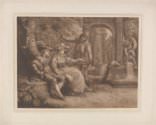Richard and Maria Cosway, and Ottobah Cugoano
Richard and Maria Cosway, and Ottobah Cugoano
1784
Richard Cosway
1742–1821
Etching and aquatint, printed in brown ink on medium, slightly textured, cream paper
12 5/8 × 15 3/8 inches (32 × 39 cm)
In 1784, the fashionable artists Richard Cosway (1742–1821) and his wife Maria (born Maria Hadfield, 1760–1838) moved to a splendid London residence at Schomberg House. In this “fancy dress” self-portrait, Richard—styling himself in the manner of the Flemish court painter Peter Paul Rubens (1577–1640)—shows himself and Maria seated in the garden of their new home. The servant who stands beside them presenting a platter of grapes is Ottobah Cugoano (b. 1757?), who worked for the Cosways from
at least 1784 until about 1791. An early biographer of Cosway recounted that Cugoano was attired “in crimson silk with elaborate lace and gold buttons, and, later on, in crimson Genoa velvet, in imitation of the footmen at the Vatican.”
Born in present-day Ghana, Cugoano was sold into slavery in 1770. Two years later, he arrived in England, where he soon gained his freedom and was baptized John Stuart. In 1787 he published Thoughts and Sentiments on the Evil and Wicked Traffic of the Slavery and Commerce of the Human Species, the most radical abolitionist text of its time. It called for an immediate end to slavery throughout the British Empire. Among subscribers to the second edition were the artists Sir Joshua Reynolds, James Northcote, Joseph Nollekens, and Cosway himself.
B1977.14.12240
Lettered, inside image, lower right: "Cosway. 1784"
Yale Center for British Art, Paul Mellon Collection

![[Untitled map of abolition of the slave trade] from Thomas Clarkson, *The History of the Rise, Progress, and Accomplishment of the Abolition of the African Slave-Trade by the British Parliament*. Beinecke Rare Book and Manuscript Library, In W890 Zz808 T. Clarkson, [Untitled map of abolition of the slave trade]](https://interactive.britishart.yale.edu/sites/default/files/styles/ycba_thumbnail/public/FoE_Clarkson_The%20history%20of%20the%20rise.jpg?itok=uMOCoiju)

